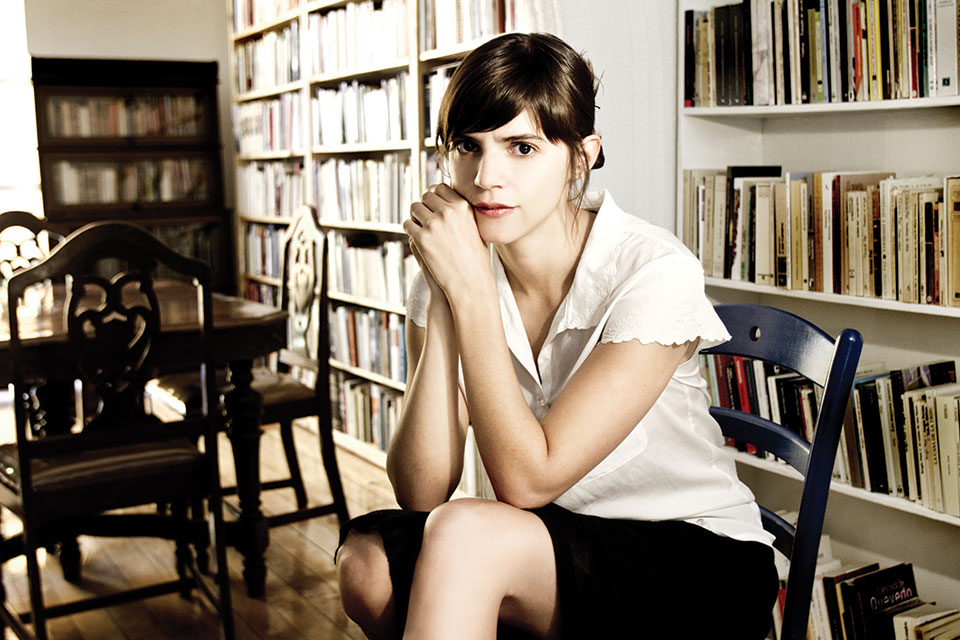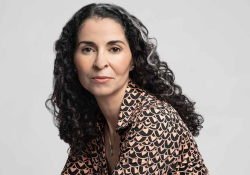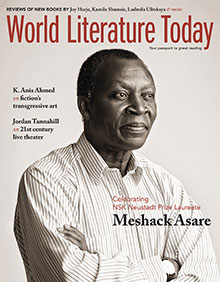Writing Yourself into the World: A Conversation with Valeria Luiselli

It may have been fate that one of Mexico’s most magnificent recent literary exports led me to another one. Finding Sergio Pitol, whose first English translation, The Art of Flight, was released by Deep Vellum in 2015, brought me to Valeria Luiselli. Now my hope is that many others discover her on their own literary path, possibly even as Luiselli did Pitol. As she explained in her piece about Pitol in Granta, on a drive through Mexico with her mother, she stopped in a bookstore. There in the foreign classics section sat Vals de Mefisto. She picked it up, began reading, and didn’t stop for the entire trip.
Luiselli sprang onto the Western literary scene in 2014 with back-to-back Coffee House Press nonfiction and fiction releases, Sidewalks and Faces in the Crowd. Her latest work is The Story of My Teeth. The novel, an absurdist and comedic romp through the world of auctioneering, blends various literary forms and stems from an interactive relationship with some Mexican factory workers. In it she brings her translator, Christina MacSweeney, out of the spotlight by giving her her own chapter.
Before she embarked on her tour for The Story of My Teeth and arrived on the University of Oklahoma campus as a juror for the 2016 Neustadt International Prize for Literature, we defined home and patriotism, connected India and Mexico, and discussed honoring translators.
Nichole Reber: I enjoyed the blend of travel memoir and essay in your Sidewalks piece, “Alternative Routes.” It made me think of conversations held while living abroad or even here in my native US in which a word or phrase of response instantly comes to me in another language that isn’t the language of the conversation. Do you find yourself sometimes getting clogged with one language while thinking, writing, or speaking in another?
Valeria Luiselli: You are describing my life. In my household, we speak a terrible mix of—at least—English, Spanish, and some Italian. I often wonder if we are killing the language of Cervantes, or if we are just mere vehicles of a future language that will be all the more complex and beautiful. But the truth is that I love hearing a good old-fashioned and conservative Spanish as much as I like hearing the “contaminated” one that circulates in Harlem, where I live. I do not have a fixed standpoint on the matter. I think Spanish will evolve into something very different than we know today, because it is a language that is still alive. But I hope we retain some memory of what it used to be.
NR: Reading Sidewalks, one gets a sense of the three viewpoints a person can have about her own country only after she’s lived abroad. There’s the perspective and opinion she develops as she’s growing up in that country, the clarity she gets when living far away from it, and then another when she returns. The third one, for me at least, was the most jarring. That’s part of the reason I so related to this book. Was writing it a sort of attempt to settle the culture shock of repatriation?
VL: It was—in an absolutely conscious and unapologetic way. I decided to write Sidewalks in order to appropriate a language and a space that was not entirely my own. It was an aspirational gesture on my part: I wanted to become a writer, a Mexican writer, an inhabitant of a city in which I had been born but had never lived, a speaker of a language that had always been only a small portion of myself. Writing is a way of writing yourself into the world, I guess. I was of course unsuccessful. I ended up writing a book not about Mexico City but other cities as well as the impossibility of writing about Mexico City. I’ve always been good at self-boycotting and self-defeating projects. I’m okay with that. By the time I finished Sidewalks, the book that would finally insert me into my hometown, I had already begun living somewhere else.
NR: I was wondering, having grown up in various countries, what is your concept of home? How about patriotism?
Patriotism is usually a soft form of cultural violence, a form of self-determination based on the discrimination of others.
VL: I disdain patriotism, unless it takes the form of caring for a community and contributing to its well-being. If being patriotic as a Mexican in the US is about helping others to assimilate and feel less humiliated about their origin and race, about backing a community’s social and cultural recognition, then yes, I am happy to be patriotic. But patriotism is usually a soft form of cultural violence, a form of self-determination based on the discrimination of others.
NR: Your work defies easy categorization—just like today’s Western literary nonfiction. We have flash, braided, hybrid, etc. How do you feel about these forms, and do you read American nonfiction writers such as Judith Kitchen, Julie Marie Wade, or Lauren Slater?
VL: I had never before heard these terms that you mention: flash, braided, hybrid. I simply like essayists—such as Charles Lamb, William Hazlitt, G. K. Chesterton, Mary McCarthy, Susan Sontag, or Natalia Ginzburg, though the list is much longer—that think about things and take me along with their train of thought, surprising me with connections I would never make. What I look for in an essayist is an intelligent and vigorous observation of the world and of others.
NR: In an interview with Asymptote you said, “The most important period of my education as a reader was in India.” Were you reading a lot of Indian authors at the time? What kind of trends do you find in that or another nation’s literature? For instance, I find in Indian literature specifically that novelists seem to discuss politics and history more than, say, American novelists. They also often make heroines of female protagonists. Rohinton Mistry’s novel A Fine Balance combines both of these.
VL: I am sorry to disappoint you, but when I arrived in India I was sixteen, so my literary education was really just beginning. I was a late bloomer, maybe. I was in high school at that time and read canonic authors from the West, more than anything. I read Shakespeare and Marlowe, Cervantes and Quevedo; I read Joyce, T. S. Eliot, and Ezra Pound; Joseph Conrad; I read Langston Hughes and Emily Dickinson; Cortázar, García Márquez. I arrived much later to Indian writers. I am currently reading the works of M. N. Roy, one of the most fascinating political thinkers I have read in a long time. He was a Bengali revolutionary and was the unlikely founder of the Mexican Communist Party. His memoirs are a masterpiece—full of fiction and exaggeration but also a testimony of early-twentieth-century internationalism in places like New York, Mexico City, Moscow, and Tokyo.
NR: As you wrote in your afterword to The Story of My Teeth, Christina MacSweeney’s addition of a final, chronological chapter “destabilizes the obsolete dictum of the translator’s invisibility and suggests a new way of engaging with translation.” How does working with her differ from working with translators who bring your work to other languages? How did you meet and decide to work together?
VL: Christina and I met about two years after we started working on her translations of my work. She has published a few articles about how we work and how we began to work together. Her version of the story is better than mine—so please feel free to ask her and include her answer here. I don’t have as close a relationship with any translator as I do with her, for the simple reason that I am not as fluent in any other second language as I am in English. Something interesting, though, is that Christina has worked closely with my translators into other languages, and together they have come up with brilliant solutions to puzzles that my work presented to them. There is a section in Faces in the Crowd, for instance, that my Italian translator, Elisa Tramontin, came up with. She produced such a good translation of it in Italian that I changed the original after her input, and so all the other translations followed her version instead of my “original.”
NR: As you can imagine, many translators read this magazine. Can you name any translators whose work you admire or who have shaped the way you work with Christina?
VL: I greatly admire Edith Grossman’s work. Her translations of Góngora are simply virtuous, genius. I am more skeptical about her translations of contemporary writers. I also admire Susan Bernofsky’s intelligence and inventiveness as a translator and as a person who reflects about translation as a genre. But I guess my absolute admiration goes to Anne Carson. She is always two centuries ahead of everyone else in everything she does.
NR: I’ve read that you’re at work on your PhD in comparative literature from Columbia. Why do you feel compelled to get a PhD?
VL: I am fortunately finished with that very long period of my life. My years at Columbia were wonderful, very formative, and intellectually intense. But they are also, happily, over and done with. I think your choice of words is good, though; it’s accurate: I indeed felt compelled to study for a PhD. On one level, I would say that I wanted a PhD because I still needed to read a lot and wanted to have access to good libraries. I needed more time to grow up, emotionally and intellectually. Columbia gave me that. But on a deeper level, I think the decision boiled down to a deep and troubled self-consciousness of my social class and nationality. There is only one other person in my family with a PhD. My family is neither rich nor prominent in intellectual or artistic circles in Mexico. Last names weigh heavily and are important in Latin America, and Luiselli doesn’t mean anything to anyone.
Being a middle-class Mexican, from a family of uneducated European migrants who arrived in Mexico City in the early twentieth century, mixed with “indigenous” Mexicans, and never really “made it,” it was somehow expected of me to finish what my ancestors had started. It was a kind of duty passed on to me. Those before me had worked their necks off so my generation could have a better life. They went through wars and revolutions, they worked since they were six or seven years old, they sustained families of up to ten to twelve children—and still found time to do social service: they were heroic in a way that my generation would never be able to even come close to.
So yes, I grew up with a sense of duty toward my ancestors, a sense of having to live up to their expectations, even if most of them died before I was born. I don’t think my late grandparents would care much for any of my accomplishments as a writer. “She writes these strange little experimental books that she then has to overexplain,” they probably say to each other, full of irony, wherever they are. But they would all proudly think of me as someone who finally went to a good school.
NR: Do you think you’ll ever translate someone else’s work? If so, what author and book would you like to work on?
VL: About ten years ago I translated several poems by Galway Kinnell. I published my translations of a few of his poems in magazines but never managed to convince anyone to publish an entire book. When he died last year, I wallowed in a sense of having failed him. I had met him when, in my early twenties, I interviewed him and told him I would take his work to Spanish readers. I never did, really. I still think The Book of Nightmares is a masterpiece, a testimony of the atrocities of twentieth-century wars and the desolation they left behind them.
I was also about to translate Anne Carson’s Nox into Spanish, but my editors at Sexto Piso never managed to buy the rights to the book. I would have loved to work with her writing. She is one of the few writers I admire fully, without any reservations. Kinnell used to say that translation was a way of allowing someone to influence and change you as a writer. I would have loved to let Carson’s work enter my own and leave an imprint there.
September 2015











